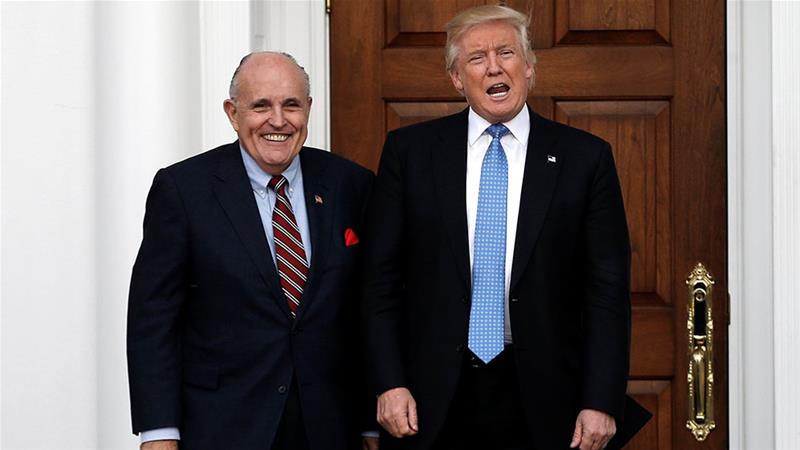Image Credits: Mike Segar/Reuters.
Dan Pfeiffer, the former White House Communications Director and senior advisor to Barack Obama, doesn’t believe that cowardice explains why Republican officeholders are not doing more to stop Donald Trump’s post-election madness. In an echo of an analysis I’ve provided, Pfeiffer declares that the Party of Lincoln is working to maximize the white vote:
Republicans represent a dwindling base of mostly white, working class voters. With every passing election, this base gets smaller. Therefore, in order to win they need to get higher and higher turnout from that base. Trump has proven that the best way to jack up turnout with these voters is through an apocalyptic, conspiracy theory laden narrative of victimization at the hands of others. The “others” in this narrative are almost always people of color. This is the core of Trump’s white nationalist immigration appeal — immigrants/gang members/Muslims are coming to your community to take your job and threaten your life. It’s bullshit, but it’s clearly powerful with a relatively sizable portion of the population.
The problem with this craven strategy is that as more educated white voters abandon the GOP, the challenge of winning an ever-larger share of a shrinking white vote gets more challenging and the victimization/race-baiting card has to do more work. That’s where all the crazy-talk comes in. Even if Republican officeholders don’t subscribe to these theories themselves, they don’t believe they can do without them and they’re probably right, at least for the moment.
But racism and cockeyed conspiracy theories were never the only play for the Republicans. Just as important as maximizing the white share of the electorate is suppressing the votes of people color and other reliable Democratic voting blocs, like highly mobile college students. That’s why we’ve seen voter ID laws proliferate and GOP officeholders in the South taking advantage of the Supreme Court’s 2013 ruling that rendered moot the Voting Rights Act’s provision that any election-related changes in most of the region be approved by the Justice Department or the D.C. Court of Appeals. It’s why Republicans purge voter lists, target early voting, resist vote-by-mail, insist on unscientific signature matching requirements, and consolidate polling stations in Democratic areas to create long lines.
For Pfeiffer, it’s a mistake to think there’s a big distinction between erecting barriers to voting and refusing to count votes. “I don’t know why anyone is surprised by this,” Pfeiffer argues, “Voter suppression has been the primary political strategy of the Republican Party for more than a decade. Throwing out legally cast ballots is barely a hop, skip and a jump from stopping legally eligible voters from casting ballots in the first place.”
If you think of elections as a two-part process, Pfeiffer makes even more sense. The first part is Election Day, along with all the early and absentee ballots. Win the most votes, and you win the election. But there are battles waged before the votes are cast over who can and cannot vote, where they can vote, how difficult it will be for them to vote, whether their ballots will be easy or difficult to challenge, and so on. By gerrymandering districts, politicians famously choose their voters rather than being chosen by them. Winning control of judicial panels makes it more likely that legal challenges will hold up in court. It helps if the governor, legislature, attorney general and secretary of state are in the control of your party. The idea is to win the election before it occurs by changing the shape of the electorate.
We can measure progress by how these two impulses compare in relative strength. Until 1920, women were not allowed to vote. The black vote wasn’t secured nationwide until 1965. Voters under 21 earned the right to vote in 1972. In recent years, early and mail voting have become more widely available, reaching an all-time high in 2020 in response to the COVID-19 pandemic. What we’re seeing now is different in the detail, as it’s still a fundamental disregard for the consent of the governed.
Curtailing the electorate undermines the legitimacy of its choices. Just as we would no longer accept an election in which women were forbidden from casting ballots, we shouldn’t accept one where voters are intentionally forced to wait in eight-hour lines or their ballots are thrown out by poll workers acting as handwriting “experts.” We certainly cannot abide Trump’s lawyers who would throw out mail-in votes or the returns from of entire counties.
Republican officeholders would be perfectly happy to go along with these extreme theories, Pfeiffer suggests, if they saw a prospect of success. They’re not tolerating Trump’s actions from simple lack of bravery:
The implication is that if things ever got really serious, the Republicans would step in to stop the election theft. I do not believe that. Math — not morals — is why Biden’s election victory is secure. He simply won by too large a margin in too many states for the results to be overturned. I believe without a shadow of doubt that if the election came down to a small margin in one state, the Republican Party — from top to bottom — would be engaged in a full fledged effort to overturn the will of the voters.
This is a conservative and reactionary impulse not a partisan one. When race baiters found their home in the Democratic Party, we had Jim Crow. Today, we have a Trump-led GOP. For both groups, the will of the people is only valid if it brings victory.
The Republicans want to support the myth of our representative system, which is why they won’t go along with simply ignoring the results of the 2020 election based on nothing more than crazed theories that don’t stand up in court. But, Pfeiffer is correct that if they could get away with stealing the election while retaining the fiction that we live in a Republic rather than a dictatorship, they would.
